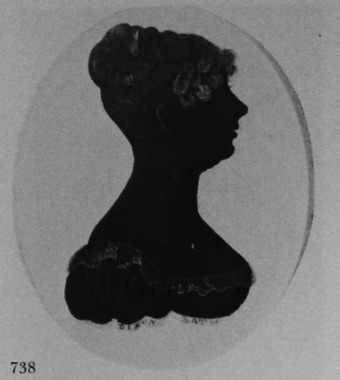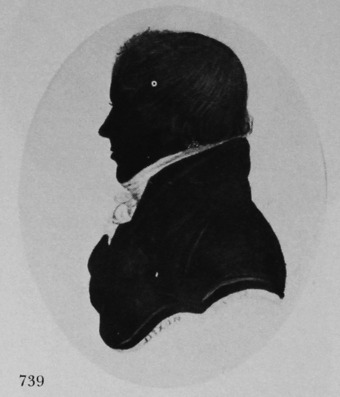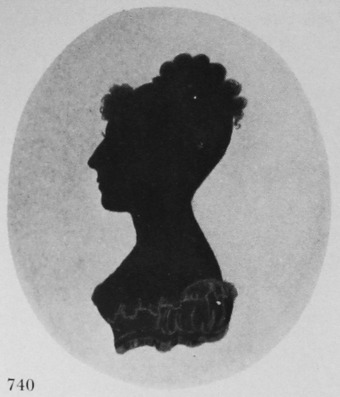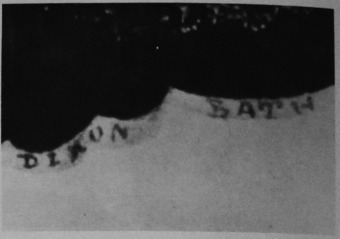Dixon, John (McKechnie Section 2)
See also Section Six
Recorded by Jackson (Dictionary) as 'M. Dixon' in one entry, 'John Dixon' in another. Other writers record either M. Dixon or two relatives, J. and M. Dixon, working as profilists and miniaturists. A search of contemporary Bath guides and directories, however, yields evidence of only one artist named Dixon: namely, John Dixon, recorded by Foskett as a miniaturist who worked at 7 Northumberland Place, Bath, 1819-22. Possibly the style 'M. Dixon', on the artist's trade label, noted by Jackson, should be read as 'Mr Dixon'.
Dixon lived and worked in Bath for some years, and offered a variety of work, as can be seen from his trade label. He is known from indexed references at the Victoria Art Gallery, Bath, to have worked in the following years at the addresses listed. In all these references he is referred to as 'Miniature Painter'. The addresses are taken from contemporary guides, directories, and collected references to Bath artists made by a former curator of the Victoria Art Gallery.
1812-13 21 St James' Parade
1815 Milsom Street
1818-26 7 Northumberland Place
1829 22 Orange Grove
1833 7 Northumberland Place
1837 8 Church Street
1841 14 Pulteney Bridge
Dixon was working at a time (1812-20) when there was Little change in the style of women's hair. To judge by his female sitters' hair-styles, he seems to have taken profiles certainly in the years 1818-26, at Northumberland Place; the illustrated examples, all signed beneath the bust-line, appear to have been painted during these years.
Jackson mentions another address, which she says she saw on cut work: the Long Room, White Hart Inn, Old Flesh Market. There was indeed a White Lion Inn next to the poulterers' and butchers' market in Bath before 1820, but this market was never, as far as I can ascertain, called the Old Flesh Market, and the artist who used this address was, in fact, W. Seville (see Section One) of Newcastle-on-Tyne. I would guess that John Dixon, a minor miniaturist, only painted profiles at times when his main profession did not guarantee him an adequate livelihood.
Only one of the varied types of profile offered on this artist's trade label is available for illustration. This is of the 'shaded black' variety. The three illustrated examples bear the signature 'Dixon Bath' in a line of shadow beneath the bust-line. The shading on these is in Chinese white, with a touch of gum arabic in the parts requiring deepest shadow.
Dixon painted these profiles at a time when the waist-line of women's dresses was high up against the bosom, being at its highest c. 1814. He terminated his profiles of women at this high waist-line with a line made up of a series of varying scallops, which were rendered well and suited the frilled tops of the dresses. Details of hair-dressing, of the sitter's ear, and of the frill at the top of the dress were all painted in Chinese white.
The illustrated silhouette of a man is terminated by a double-loop concavity, the two loops being of much the same size. The shape of the bust-line is stressed by a line of white paint above, while the same line of shading is shown right at the bottom, bearing the signature. Plain black profiles by Dixon might be identified by these unusual bust-line terminations. Any extant bronzed profiles would no doubt be much the same as 'shaded' profiles, gold paint taking the place of white. These three illustrated silhouettes seem to exemplify the type of profile painted on card by John Dixon; there is no evidence that he painted in full-length, and in view of the variety of bust-length work that he offered, it is unlikely that he also produced full-length examples.
Two of the illustrated examples are in original papier mâché frames, with different floral motifs.
Dixon's only known trade label, recorded by Jackson, reads as follows:
M[r] DIXON
Miniatures and Profiles
7, Northumberland Place,
Bath.
Miniature from 7 guineas
Miniature on card £1. 1s.
Coloured on Ivory £1. 11s. 6d.
Cameo Profile on ivory £1. 11s. 6d.
Bronze Profiles 5s.
Black shaded profile 2s. 6d.
Black Shade 1s.
Exclusive of frame and glass.
Clearly, Dixon was prepared to offer a vide variety of work. 'Cameo' profiles were much favoured by Bath artists.
A specimen of Dixon's signature is illustrated.
Ills. 738-741

Unknown woman
Silhouette painted on card with detail in Chinese white and gum arabic
c. 1818
3 x 2½in./77 x 64mm.
Frame: papier mâché
Signed ‘Dixon Bath’ in a line of shading below the bust-line.
Crown Copyright. Victoria and Albert Museum, No. P68-1924

Unknown man
Silhouette painted on card, with detail in Chinese white and gum arabic
c. 1818
3 x 2½in./77 x 64mm.
Frame: papier mâché
Signed in a line of shadinf below the bust-line. The sitter was probably the husband of the sitter in 738.
Crown Copyright. Victoria and Albert Museum, No. P69-1924

Unknown woman
Silhouette painted on card, with detail in Chinese white and gum arabic
c. 1820
3 x 2½in./77 x 64mm.
Signed in a line of shading below the bust-line.
R. Kilner collection

Signature of John Dixon.
Crown Copyright. Victoria and Albert Museum, No. P68-1924
